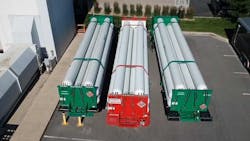Roundtable: Hydrogen Has Promise as Future Backup Power Solution
Today we conclude our Data Center Executive Roundtable, as our panel looks at the technologies that can drive long-term sustainability for the data center industry – including hydrogen, which was mentioned by several of our experts. Our panelists include Rob Rockwood from Sabey Data Centers, Lenaik Andrieux from Kohler Power Systems, Nancy Novak of Compass Datacenters and Infrastructure Masons, and Peter Panfil from Vertiv.
The conversation is moderated by Rich Miller, the founder and editor of Data Center Frontier. Here’s today’s discussion:
Data Center Frontier: As sustainability takes on greater urgency, hyperscale operators are testing new approaches to power infrastructure, including integrating more renewables and innovations in backup power and fuel. What are the most likely advances ahead in data center power?
ROB ROCKWOOD, Sabey Data Centers
Rob Rockwood, Sabey Data Centers: While weather-related disasters may not affect site selection as much as one may think, certainly the availability of low-cost renewable energy will, and particularly energy with long-term price stability.
Data center providers will replace diesel generators with natural gas generators in the near term, and hydrogen generators in the long term; not just for emergency backup, but market participation as well. Established hydroelectric power will remain a popular choice in certain regions, and behind-the-meter solar power and battery storage will become attractive options.
LENAIK ANDRIEUX, Kohler Power Systems
Lenaik Andrieux, Kohler Power Systems: This is a very important and deeply complicated topic. There are a number of technologies that can deliver centralized or distributed power, as prime or standby sources. They have their specific benefits and drawbacks on the environment. Nuclear, hydro, coal-fired, diesel, gas, solar and wind-powered power plants are commonly deployed around the planet. Energy storage technology is also now available. Hydrogen and natural gas fuel cells are emerging, and some are beginning to substitute diesel with HVO, bio-diesel or even hydrogen in recip engines.
There are a lot of choices and over the recent years we have witnessed deployment of commonly accepted sustainable solutions but not necessarily taking into account the sustainability of the whole supply chain that ultimately provides the power to the end-user. This assessment of the environmental impact of the full energy supply chain seems key to selecting the right technology.
Does it make sense to recharge energy storage devices through a coal-fired utility contract? Same question goes for how the production of hydrogen is achieved, before it is used as a fuel. Conversely, diesel generator could be seen has having a significant environmental impact when used as a prime source. Yet, when used purely as an energy insurance device, in standby mode, with “stretched” training intervals, what is their true impact? Beyond the type of “fuel” used and the energy producing technology, the understanding of the raw material content, its origin, the way it is “mined,” transported, and transformed also have to be significant elements to declare if that specific energy technology sustainable.
NANCY NOVAK, Compass Datacenters and iMasons
Nancy Novak, Compass and iMasons: To a certain extent innovations in power delivery will be a function of company size. In multiple areas it’s companies like Google, Microsoft and AWS whose sheer size necessitates they develop solutions to address requirements unique to them that then filter down to smaller providers over time. In terms of power I don’t think it is unreasonable to expect them to become power producers themselves by establishing their own solar or wind powered microgrids to service some if not all of their locations’ power requirements.
While still in the early stages of development, I wouldn’t be surprised to ultimately see one or more of these same companies power their locations through the use of small nuclear reactors. Companies like Bill Gates’ TerraPower are working to develop solutions to make nuclear a more practical energy source, which makes sense since it does not suffer the same limitations as other renewable energy sources. Naturally, this isn’t something we’re going to see in the next five years but I think we’re increasingly coming to the realization that the ability to meet both corporate and our national emissions reductions goals is going to have to incorporate nuclear technology.
“While still in the early stages of development, I wouldn’t be surprised to ultimately see one or more of these same companies power their locations through the use of small nuclear reactors.”
Nancy Novak, Compass and iMasons
Perhaps the area that will have the largest near term impact on the whole power equation is battery technology. The ability to store energy produced by wind and solar is the major hurdle that needs to be overcome to increase their efficiency to the point that they are true fossil fuel alternatives.
PETER PANFIL, Vertiv
Peter Panfil, Vertiv: Hyperscale operators have set ambitious sustainability goals. To realize those goals they are driving innovation in how data centers are powered, ultimately moving to locally generated renewable power supporting clean hydrogen production. The key barriers today are issues related to hydrogen costs, distribution and production, but progress is being made on all fronts. Advances in these areas, combined with the continued maturity of fuel cell and renewable energy technologies, will enable a solution in which renewably powered on-site hydrogen production supports fuel cells that serve as the primary source of data center power, with the utility, UPS and lithium-ion batteries working together to provide backup power as needed.
The traditional role of the UPS is expanding from power protection and conditioning to include demand management, fast frequency response and grid services.
NEXT: A full recap of this DCF Executive Roundtable, along with Executive Insights transcripts.
Keep pace with the fact-moving world of data centers and cloud computing by following us on Twitter and Facebook, connecting with DCF on LinkedIn, and signing up for our weekly newspaper using the form below:
About the Author





